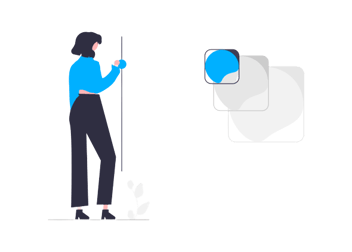How do I improve online shopper experience?
If your brand is searching for ways to improve your processes and generate growth, you should consider focusing on the e-commerce Customer Experience.
E-commerce is booming and if you’re looking for ways to stand apart from the competition, improving the online shopping process is key. Customers opt to shop online because of the convenience, simplicity, and efficiency so you need to meet those expectations.
Improving your e-commerce systems can be daunting, so we’ve made it easy with 8 core principles to focus on.
E-commerce Customer Experience
Good e-commerce is about more than just selling your products and services online, it’s also about creating an experience that customers find enjoyable, effortless, and satisfying. As part of the wider Customer Experience (CX), e-commerce should focus on the customer’s needs, cultivating trust and ongoing loyalty.
Customer Experience is all about how customers perceive your brand based on the quality of the customer service, products, and general User Experience (UX). In terms of e-commerce, that includes:
- Communications across digital channels
- Product browsing and selection
- Availability of product and general information
- Delivery time and procedure
- The transaction process
- Packaging methods and materials
Improving the Customer Experience for e-commerce
By improving the experience of your online customers, you’re sure to see significant revenue growth. That’s because satisfied customers are more likely to return for further purchases, as well as refer your brand to others.
Customers have a lot of power in the modern marketplace and can easily switch brands if they aren’t enjoying their experience, so you need to start paying attention to their demands. An elevated Customer Experience is now a differentiating factor between brands and 86% of consumers are prepared to pay extra for it, even if the product itself is the same.
8 ways to improve your e-commerce experience
To improve customer retention and increase revenue, now is the time to hone in on your e-commerce services. To help you get started, here are the 8 best ways to level up your online shopping Customer Experience. In summary, these are:
To discover each in detail dive into what they entail, and why they're important below.
1. Make your website user-friendly
Websites are your e-commerce hub, bringing everything together into one centralised place. The key to a good website is ensuring it’s easy to use and appealing. This way customers will want to spend more time on it and be inclined to visit again.
Optimise your product pages
When online shopping, customers want to browse all their options in a simple format. Your products should be displayed in a way that makes this process as easy as possible, with all the necessary information for each product displayed clearly.
The best practices for products pages include:
- High-quality product photography.
- Intuitive layout with clear call-to-action buttons.
- Displaying shipping information.
- Include social proof through product reviews.
Have a seamless checkout process
Another key focus for your e-commerce website should be to offer an effortless purchase experience. That means providing multiple payment methods, including delivery fees, and improving security for customers' personal information.
2. Personalisation
Increasingly, customers expect brands to interact with them in a personalised way and with automation and Customer Relationship Management (CRM) tools, it’s never been easier.
Incorporating personal data into communications, such as the customer's first name, goes a long way toward making them feel heard and valued. When it comes to customer support, emails, and your website, these simple details are incredibly powerful for customer engagement.
3. Enhance customer support
When dealing with customers online, you need to have an effective support system in place for resolving problems and helping them to use your products. The main thing with customer support for e-commerce is that you need to be available and responsive.
A popular way to achieve this is by incorporating a live chat feature into the website so that customers can reach out as soon as they have a question.
4. Optimise for mobile
With the way technology is going, e-commerce brands need to be as mobile-friendly as possible. Since a large part of the appeal of online shopping is being able to do it any place and any time, mobile is the ultimate e-commerce tool.
If your website isn’t set up for mobile, customers are likely to be deterred by how difficult it is to engage with. Even if your desktop website works perfectly, mobile screens and functions are entirely different. The most effective method is to work with a developer, designer, and website agency to ensure the mobile version of your website is just as good.
5. Offer a clear returns policy
When buying online, customers don’t have the same confidence in the products that they do in-store because they can’t try them on or test them out for themselves. Because of this, it’s a good idea to offer a returns policy that reassures the customer that they can get their money back, or at least credit, if the product doesn’t meet their expectations.
Your returns policy needs to be clear and easy to locate so that customers can access it and understand their rights. If you provide this, customers are more likely to trust you, and therefore willing to invest.
6. Order confirmations and delivery notifications
Another critical part of the online buyer’s journey is receiving updates and communications at certain times. For example, order confirmations and delivery notifications provide customers with reassurance and confidence that their purchase will come to fruition.
With the rise of online scams and fraud, customers appreciate the extra confirmations you send because they can be confident they are dealing with a trustworthy brand and reputable business. The more secure, verifiable, and reassuring the customer journey, the more likely they are to invest again.
7. Product reviews
By displaying customer reviews for your products, you increase the social proof available for prospective customers to see. This way, people can see what existing customers have said about the product, including its quality and functionality.
Most commonly, product reviews include star ratings and comments, so that customers can assess how a product measures up to its description.
8. Measure customer satisfaction
Like any aspect of the Customer Experience, it’s crucial to get in touch with customer satisfaction through feedback. By asking customers what they think and how they feel, you can identify common problems sooner and analyse what needs to be improved.
Customer Satisfaction (CSAT) surveys are a great tool for this and can be sent at any point in the customer journey. These surveys ask customers how well the brand has met their needs, what could have been done differently, and how they feel about the interaction overall. In asking these questions, you can determine what the most effective course of action is for your business.
For more tips to harness the power of customer feedback, sign up for the Review Tui software launch later this year. Or download our guide to get started today. You’ll find everything you need to implement an effective customer feedback strategy and improve your Customer Experience.



